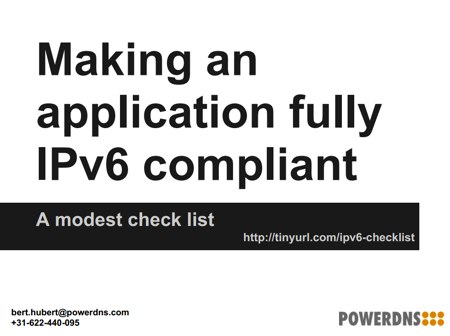Today at the RIPE66 meeting in Dublin, Ireland, Bert Hubert of PowerDNS fame gave a great presentation about “Making an application fully IPv6 compliant“:

The video and audio for the session should be available soon. I very much enjoyed Bert’s presentation and he had a few points that I will think about adding to the next version of the book. One specific point is around collecting statistics. Bert noted that in IPv4 you again typically only have one IP address to worry about for each connection, while in IPv6 you may have many different IP addresses for a connection (or you could have). And so you may need to think about your storage of all that statistics information.
I only had two minor quibbles with Bert’s slides:
- On slide 11, Bert suggests there could be several different ways of displaying IPv6 addresses with port numbers. As I stated in the question time, RFC 5952 states that it should be Bert’s choice “a”.
- On the issue of how to choose whether to use the IPv6 or IPv4 interface, the “Happy Eyeballs” technique defined in RFC 6555 is one that many developers are now using.
Overall, I was very glad to see Bert’s presentation out there as we need to have more such presentations helping application developers think about these issues of migrating to IPv6.
P.S. If you want to easily refer people to Bert’s slides, he provided the very easy URL of:

